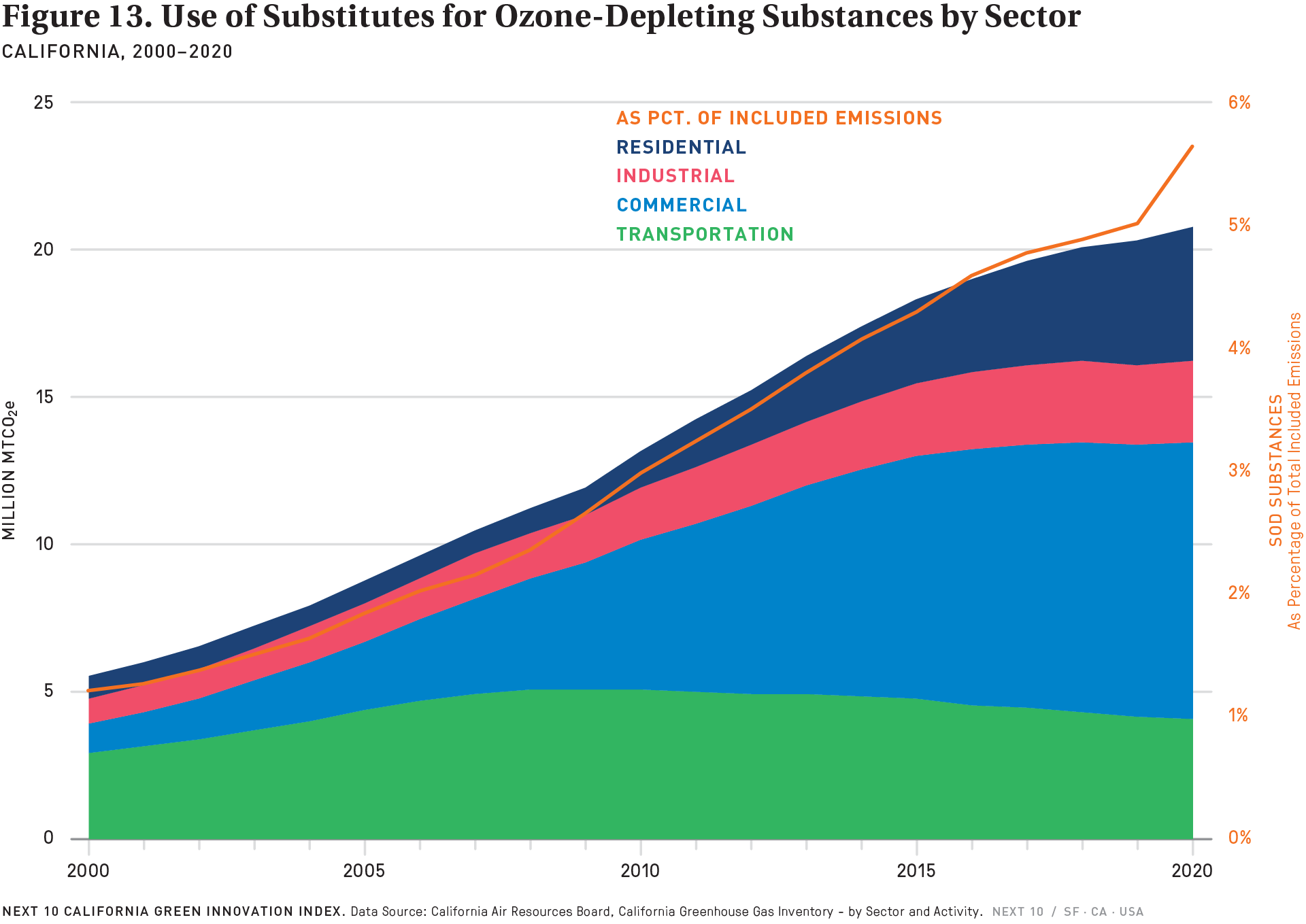Challenge
- Emissions from the use of Substitutes for Ozone-Depleting Substances (substitutes for ODS),35 which emit high global warming potential (GWP) gases such as hydrofluorocarbons (HFCs) and perfluorocarbons (PFCs), are the fastest-growing source of GHG emissions in California—especially within the commercial sector. In 2020, GHG emissions from substitutes for ODS from all economic sectors accounted for 5.6 percent of total included statewide emissions, up from the 2019 share (4.9%) and a considerably larger share compared to 2008 (2.3%) and 2000 (1.2%). Worldwide, emissions of high GWP gases from substitutes for ODS are rising as they are used for purposes such as refrigeration and air conditioning.36,37,38,39
- For the commercial and industrial sectors, emissions from substitutes for ODS are associated with aerosols, fire protection, foams, solvents, and refrigeration and air conditioning activities, of which refrigeration and air conditioning activities are the main drivers of the increase in GHG emissions from substitutes for ODS. The primary refrigerants used for these sectors that contribute to the majority of the increase in GHG emissions are refrigerants R-125, R-134a, and R-143a,40 which have global warming potentials of 3,500 times, 1,430 times, and 4,470 times, respectively, of the GWP of carbon dioxide.41 In the residential sector, R-32a (with a GWP of 675 times of that of CO2) is commonly used alongside R-125 and R-134a (R-143a is not used in the residential sector). In 2020, GHG emissions from these four refrigerants across all industries and activities totaled 20.8 MMTCO2e, up 2.23 percent compared to 2019. These four refrigerants accounted for 94.1 percent of GHG emissions from all substitutes for ODS in 2020. Moreover, GHG emissions from these refrigerants have all been rising over time, with R-125 rising the fastest (+37 percent from 2015 to 2020). Extreme heat from climate change is likely to increase the use of these refrigerants, ultimately resulting in even more GHG emissions. The new U.S. commitment to reduce the use HFCs should help mitigate some of these increases.
35 Emissions occur when they are released into the atmosphere (e.g., from fire extinguishers or aerosol cans) or when they leak out of equipment such as refrigerators and air conditioning units.
36 Significant New Alternatives Policy. U.S. Environmental Protection Agency. Available at: https://www.epa.gov/snap/global-emissions-substitutes-ozone-depleting-substances
37 The 1987 Montreal Protocol aimed to protect the Earth’s ozone layer by phasing out Ozone-Depleting Substances, but increased utilization of substitutes for ODS have resulted in an unintentional growth of GHG emissions. See: United Nations Environmental Program (2016). Treaties—The Montreal Protocol on Substances that Deplete the Ozone Layer. Available at: https://ozone.unep.org/treaties/montreal-protocol/amendments/kigali-amendment-2016-amendment-montreal-protocol-agreed
38 The Kigali Amendment (adopted in 2016 and entered into force in January 2019) to the Montreal Protocol aims to address the emissions problem that substitutes of ODS have presented by phasing down global production of these substances and creating market certainty to allow growth of more environmentally friendly alternatives. President Biden announced plans to ratify the Kigali agreement in April 2021, and it was ratified in September 2022.
39 While the Kigali agreement could help shape markets for these substances to reduce GHG emissions, at the state level, California has a number of programs aimed at reducing emissions from these substances as outlined in the 2017 Short-Lived Climate Pollutant Reduction Strategy. See: Short-Lived Climate Pollutant Reduction Strategy from March 2017. California Environmental Protection Agency and California Air Resources Board. Available at: https://ww2.arb.ca.gov/sites/default/files/2020-07/final_SLCP_strategy.pdf
40 The American Society of Heating, Refrigeration and Air-Conditioning Engineers (ASHRAE) Standard 34 assign refrigerant designations. Available at: https://www.ashrae.org/technical-resources/standards-and-guidelines/ashrae-refrigerant-designations
41 GWP values are based on AR4 100-year GWP values. A list of refrigerants and the associated GWPs are available at California ARB’s webpage on High-GWP Refrigerants: https://ww2.arb.ca.gov/resources/documents/high-gwp-refrigerants
Opportunity
- In September 2022, the U.S. Senate voted to ratify the Kigali Amendment to the 1987 Montreal Protocol, first proposed in 2016, joining 137 nations who had already signed on. This binding resolution will reduce the use of HFCs in refrigeration and air conditioning, which will reduce emissions from these substances. This action further solidifies the U.S. commitment to climate action and reducing HFCs, while also protecting U.S. industries. If the amendment had not been ratified, segments of the chemical and manufacturing industries would be closed to U.S. producers after 2023 due to other stipulations in the Montreal Protocol.42
42 McKenna, Phil. Senate Votes to Ratify the Kigali Amendment, Joining 137 Nations in an Effort to Curb Global Warming. Inside Climate News. Sept. 24, 2022.

